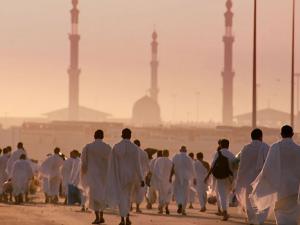Short Description
Taking a closer look at the Muslims’ spiritual journey of hajj, Paris has opened a special exhibition to explore how the life-time journey has changed over hundreds of years, showcasing works of art, photography, rare manuscripts and textiles.
Taking a closer look at the Muslims’ spiritual journey of hajj, Paris has opened a special exhibition to explore how the life-time journey has changed over hundreds of years, showcasing works of art, photography, rare manuscripts and textiles.
“We go from the very contemporary to pieces that go back 1,500 years; the emotions are the same,” the exhibition curator Omar Saghi, told Agence France Presse (AFP) on Tuesday, April 29.
Haj was “present in the heart of all Muslims,” he added.
Titled “Haj: journey to the heart of Islam,” the exhibition opened at Paris’s Arab World Institute, in partnership with the King Abdulaziz Public Library in Riyadh.
The exhibition, which runs until August 10, features changes that have come to hajj and Makkah, almost 1500 years after Prophet Muhammad (peace be upon him) received revelations from Allah.
At the beginning, pilgrims came on camels or on foot in their thousands. Now, millions of Muslims make the journey to Makkah each year, traveling by boat, coach and budget airline with an ever-increasing numbers.
As new modes of transport and technological advances were discovered over the past century, the number of pilgrims in 2012 reached over three million pilgrims, 1.6 of who came by air.
The meaning of hajj, however, remained the same as the museum stressed the human aspect with identity cards, water bottles, guide books and souvenirs.
Muslims from around the world pour into Makkah every year to perform hajj, one of the five pillars of Islam.
Hajj consists of several ceremonies, which are meant to symbolize the essential concepts of the Islamic faith, and to commemorate the trials of Prophet Abraham and his family.
Every able-bodied adult Muslim who can financially afford the trip must perform hajj at least once in a lifetime.
Inspiration
The exhibition features centuries-old miniatures and sections of elaborate pilgrimage certificates, reflecting how hajj has always been a source of inspiration for artists.
More recent works include “Pilgrims Going to Makkah” by 19th Century French artist Leon Belly, depicting a column of people on camel and foot, as well as contemporary art installations.
An 18th Century pen and ink “map” of the Ottoman Empire with Makkah at its center shows a sparsely populated city surrounding the Masjid Al-Haram (the Sacred Mosque) that illustrates the changes in scale that have taken place.
Today, the mosque is the biggest in the world covering an area of 350,000 square meters.
A large-scale photographic work by Ahmed Mater, a Saudi artist, shows the mosque as it is today with the foreground filled with cranes bowed over unfinished buildings.
In the background, the Abraj Al-Bait Towers complex can be seen with the outline of the mountains in the distance.
The largest of its towers, known as the Makkah Royal Clock Tower, is at 601 meters, six times as high as London’s Big Ben.
The exhibition is not the first international event to feature Muslims hajj journey.
Last October, a special exhibition about hajj “Journey Through Art” was launched in Qatar, offering audiences a local interpretation of the Muslim pilgrimage to Makkah.
In 2012, the British Museum hosted a major exhibition on the Muslim hajj to educate non-Muslims about one of the five pillars of Islam.
The UK exhibition, billed as the world’s largest on hajj, traced some of the main routes Muslims have followed over the centuries to get to Makkah.
http://www.onislam.net/english/news/europe/471951-french-exhibition-showcases-spirit-of-hajj.html






![نصيحتي لك: اذكر الله [1 / 12] نصيحتي لك: اذكر الله [1 / 12]](http://97.105.52.213/images/upload/content_thumbs/1913613138ragheb-al-serjany-videos.jpg)


Comments
Send your comment